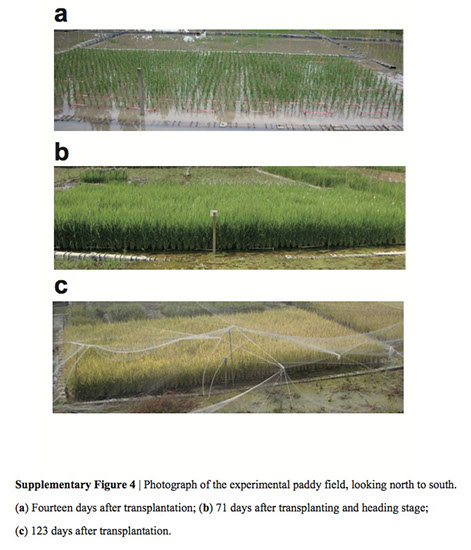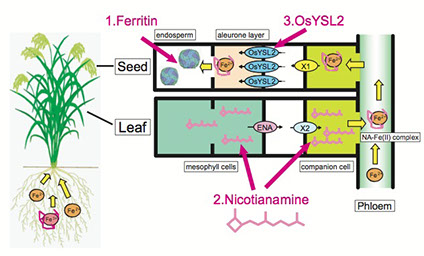ホーム / インプランタについて / ニュース / 120808
【2012年8月8日】
弊社の韓国屋外圃場でデータを取られた論文がNatureグループのオンライン・オープンアクセス誌「Scientific Reports」に掲載されました
東京大学の西澤直子教授チームが発表された論文、「鉄栄養に関わる複数の遺伝子の導入による、白米中の鉄分強化 (Iron biofortification in rice by the introduction of multiple genes involved in iron nutrition)」がNatureグループのオンライン・オープンアクセス誌「Scientific Reports」に掲載されました。
当論文の中で記載されている遺伝子組換えイネの屋外実証実験およびデータ採取は、弊社が韓国にて運営する屋外隔離圃場にて行われました。弊社では、東京大学の西澤直子教授チームからの依頼を受け、該当遺伝子組換えイネの栽培及びデータ取り、種子の採取を行いました。また、組換え体の輸出入に関する申請や行政対応までトータルにサポートさせていただきました。
>> Nature - Scientific Reports
下記、東京大学の西澤直子教授チームが発表された論文の要旨を転載させていただきます。
インプランタについて
鉄栄養に関わる複数の遺伝子の導入による、白米中の鉄分強化
Iron biofortification in rice by the introduction of multiple genes involved in iron nutrition
Scientific Reports 2, Article number: 543 doi:10.1038/srep00543
Received 08 May 2012 Accepted 29 June 2012 Published 30 July 2012
Nature - SCIENTIFIC REPORTS
Hiroshi Masuda, Yasuhiro Ishimaru, May Sann Aung, Takanori Kobayashi, Yusuke Kakei, Michiko Takahashi, Kyoko Higuchi, Hiromi Nakanishi & Naoko K. Nishizawa
要旨:
世界的に最も深刻なヒトの微量栄養素欠乏症の一つである鉄欠乏性貧血症の問題を解決することを目的とし、次の三つの遺伝子学的手法を組み合わせた鉄分強化米を作出した。1.胚乳特異的発現を誘導するプロモーターの制御下で、鉄貯蔵タンパク質フェリチンを発現させ、種子中の鉄貯蔵能力を強化する。2.植物が本来持つ金属キレーターであるニコチアナミンの過剰生産により、植物体内の鉄輸送を強化する。3.胚乳特異的発現を誘導するプロモーターとスクロース輸送タンパク質のプロモーターの制御下で、二価鉄ニコチアナミントランスポーター、OsYSL2を高発現させることにより、胚乳組織への鉄の輸送を強化する。このようにして作出した鉄分強化米は、温室で栽培したT2種子の白米で、非形質転換体と比較して6倍の鉄濃度を示した。さらに圃場水田で栽培したT3種子の白米では4.4倍の鉄濃度を示した。一方、特に収量の減少は見られなかった。さらに、亜鉛は圃場水田で最大1.6倍に増加した。我々は、イネの鉄分を強化させる場合、個々の遺伝子を単独で導入するよりも、複数の鉄栄養に関わる遺伝子を同時に導入した方が、より効果的であることをこの報告により示している。
Abstract:
To address the problem of iron-deficiency anemia, one of the most prevalent human micronutrient deficiencies globally, iron-biofortified rice was produced using three transgenic approaches: by enhancing iron storage in grains via expression of the iron storage protein ferritin using endosperm-specific promoters, enhancing iron translocation through overproduction of the natural metal chelator nicotianamine, and enhancing iron flux into the endosperm by means of iron(II)-nicotianamine transporter OsYSL2 expression under the control of an endosperm-specific promoter and sucrose transporter promoter. Our results indicate that the iron concentration in greenhouse-grown T2 polished seeds was sixfold higher and that in paddy field-grown T3 polished seeds was 4.4-fold higher than that in non-transgenic seeds, with no defect in yield. Moreover, the transgenic seeds accumulated zinc up to 1.6-times in the field. Our results demonstrate that introduction of multiple iron homeostasis genes is more effective for iron biofortification than the single introduction of individual genes.


All rights reserved - Inplanta Innovations Inc.
